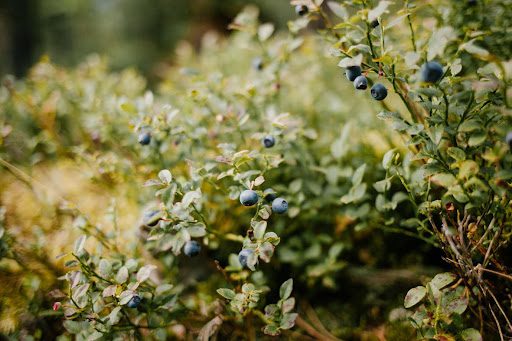Maine is known for its delicious blueberries, and if you’re a property owner in the state, you may be wondering how to plant blueberries yourself. Blueberry bushes are a beautiful addition to any landscape, providing fresh fruit for your family all summer long. In this blog post, we will discuss some tips that can help you grow healthy blueberry bushes on your Maine property.
1. Site Selection & Preparation
When choosing a location for growing wild blueberries, selecting an area that receives full sun for at least six hours per day is important. Blueberry bushes also need well-drained soil to thrive. If your property has heavy clay soils, you may want to consider raised beds or mounds for planting. Once you have selected the perfect site, prepare the soil by amending it with organic matter such as compost or peat moss. This will help improve drainage and increase fertility.
It is also essential to test the soil’s pH level before planting blueberries. The ideal pH range for blueberries is between 4.5 to 5.2, so if your soil is too acidic or too alkaline, you will need to adjust it. This can be done by adding sulfur or lime to the soil, respectively. We suggest you have your soil tested by Maine Soil Testing Service.
2. Choosing Varieties
When you’re selecting blueberry bushes for your property, choose varieties that are well-suited to the Maine climate. There are several types of blueberries, and while each type has its unique flavor, some are better suited for particular uses than others.
Some varieties that do well in Maine include:
Bluecrop
Bluecrop is a highbush blueberry that is known for its large berries and excellent flavor. This variety is great for fresh eating, baking, and making jams and jellies. Bluecrop plants produce high yields of large, deep blue berries with a good balance of sweetness and acidity. The fruit ripens slightly later than other highbush varieties, which makes it perfect for extending the blueberry season. Bluecrop plants are also relatively resistant to powdery mildew, making them a good choice for gardeners in areas where this disease is common.
Blueray
Although Bluecrop is the most widely planted blueberry variety, many other delicious varieties exist. Blueray is one such variety. Named for its large blueberries, Blueray is known for its sweet flavor and juiciness. This variety ripens earlier than Bluecrop, making it a great choice for those who want to enjoy fresh berries as early as possible. In addition to being tasty, Blueray berries are also perfect for baking. Whether you’re making pies and muffins, or simply enjoying them on their own, Blueray berries are sure to please.
Patriot
Patriot is an early-season lowbush blueberry variety that produces small but flavorful berries. The fruit of Patriot plants is perfect for eating fresh, and the plants themselves are compact and easy to grow. This variety is a good choice for those who want to add blueberries to their landscape without taking up too much space.
Jersey
Jersey is a late-season, highbush blueberry variety that produces medium-size, sweet berries. This variety is perfect for those who want to extend their blueberry season into the fall. The fruit of Jersey plants is also great for baking and making jams and jellies.
Now that you know a little bit more about some of the different varieties of blueberries that grow well in Maine, you can choose the right ones for your property. Remember, when selecting varieties, it is important to consider not only flavor but also ripening time and disease resistance. With a little bit of planning, you can have delicious blueberries growing on your Maine property in no time!
3. Planting & Caring for Bushes
Once you have selected the perfect site and your desired varieties, it’s time to plant! Blueberry bushes are typically grown in the spring after all danger of frost has passed. When planting, be sure to dig a hole that is twice as wide as the root ball of your bush. This will give the roots plenty of room to grow and establish themselves. Once the hole is dug, simply backfill it with soil and water well.
It is important to water your blueberry bushes regularly, especially during the first year after planting. They should be watered deeply so that the water penetrates down to the root zone. A good rule of thumb is to provide each bush with one inch of water per week. If you live in an area with a lot of rainfall, you may not need to supplement with additional watering.
In addition to regular watering, blueberry bushes also need fertilizer. We recommend using an organic fertilizer that is high in nitrogen and low in phosphorus. An example of such fertilizer is a blood meal. A blood meal is a great source of nitrogen and can be easily applied to your plants by top dressing them with a thin layer of the powder.
Once your bushes are established, you will need basic maintenance to ensure a bountiful harvest each year. This includes pruning, thinning, and mulching. We’ll go over each of these tasks in more detail below.
Pruning
Pruning is an important part of caring for blueberry bushes. It helps to encourage new growth and promote fruit production. Bushes should be pruned annually, in late winter or early spring, before new growth begins. When pruning, always remove any dead or diseased wood first. Next, cut back any overgrown branches. Finally, thin out the bush’s center to allow light and air to reach the fruit.
Thinning
In addition to pruning, you will also need to thin your bushes each year. This is done after the flowers have bloomed and before the berries begin to form. Thinning helps to improve air circulation and allows the sun to reach all of the berries, which in turn improves their flavor. To thin, simply remove any excess branches, but make sure you do damage the remaining ones.
Mulching
Mulching is another important task when it comes to caring for blueberry bushes. Mulch helps to keep roots cool in summer and warm in winter. It also helps retain moisture and prevents weeds from growing. The best type of mulch to use is an organic material, such as pine needles, straws, or wood chips. Apply a layer of mulch around the base of each bush, being sure to keep it away from the trunk.
Want To Add Wild Blueberries To Your Landscaping?
If you are considering adding wild blueberries to your landscaping, we can help! Stone Solutions Maine offers professional garden landscaping in the greater Portland area. We specialize in native plantings, including wild blueberries.
Contact us today to learn more about our services and how we can help create the perfect landscape for your Maine property.

